
The Project Gutenberg EBook of The Raven and The Philosophy of Composition, by Edgar Allan Poe This eBook is for the use of anyone anywhere in the United States and most other parts of the world at no cost and with almost no restrictions whatsoever. You may copy it, give it away or re-use it under the terms of the Project Gutenberg License included with this eBook or online at www.gutenberg.org. If you are not located in the United States, you'll have to check the laws of the country where you are located before using this ebook. Title: The Raven and The Philosophy of Composition Author: Edgar Allan Poe Illustrator: Galen J. Perrett Release Date: October 14, 2017 [EBook #55749] Language: English Character set encoding: UTF-8 *** START OF THIS PROJECT GUTENBERG EBOOK THE RAVEN, PHILOSOPHY OF COMPOSITION *** Produced by Richard Tonsing and the Online Distributed Proofreading Team at http://www.pgdp.net (This file was produced from images generously made available by The Internet Archive)
Transcriber's Note:
The cover image was created by the transcriber and is placed in the public domain.


Copyright 1906 by The Harwell-Evans Co.
Lenore
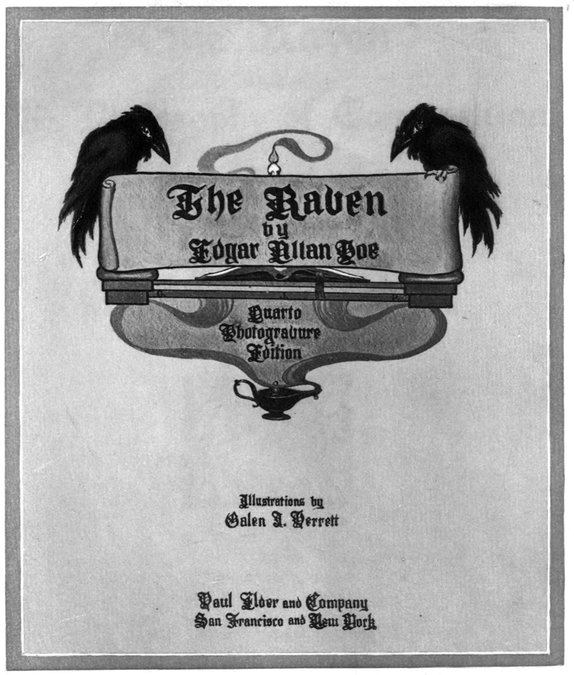
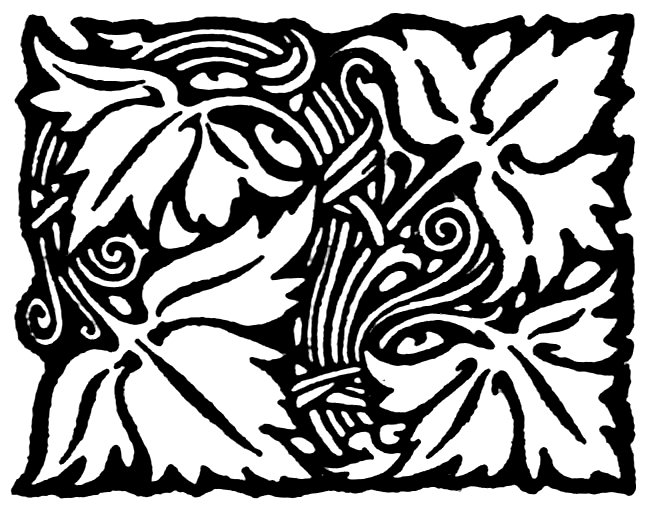
The initial intention of the publishers to present “The Raven” without preface, notes, or other extraneous matter that might detract from an undivided appreciation of the poem, has been somewhat modified by the introduction of Poe’s prose essay, “The Philosophy of Composition.” If any justification were necessary, it is to be found both in the unique literary interest of the essay, and in the fact that it is (or purports to be) a frank exposition of the modus operandi by which “The Raven” was written. It is felt that no other introduction could be more happily conceived or executed. Coming from Poe’s own hand, it directly avoids the charge of presumption; and written in Poe’s most felicitous style, it entirely escapes the defect—not uncommon in analytical treatises—of pedantry.
It is indeed possible, as some critics assert, that this supposed analysis is purely fictitious. If so, it becomes all the more distinctive as a marvelous bit of imaginative writing, and as such ranks equally with that wild snatch of melody, “The Raven.” But these same critics would lead us further to believe that “The Raven” itself is almost a literal translation of the work of a Persian poet. If they be again correct, Poe’s genius as seen in the creation of “The Philosophy of Composition” is far more startling than it has otherwise appeared; and “robbed of his bay leaves in the realm of poetry,” he is to be “crowned with a double wreath of berried holly for his prose.”
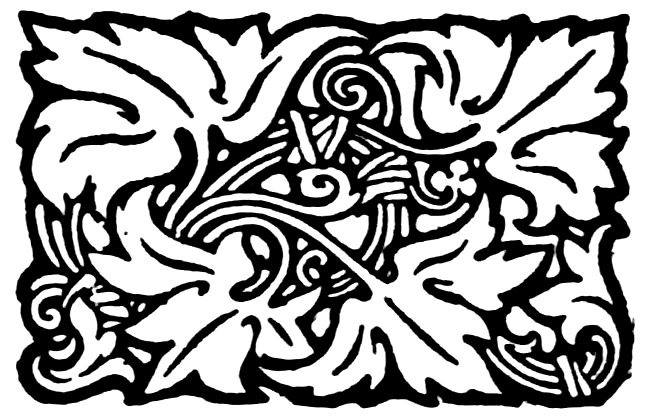

Charles Dickens, in a note now lying before me, alluding to an examination I once made of the mechanism of “Barnaby Rudge,” says—“By the way, are you aware that Godwin wrote his ‘Caleb Williams’ backwards? He first involved his hero in a web of difficulties, forming the second volume, and then, for the first, cast about him for some mode of accounting for what had been done.”
I cannot think this the precise mode of procedure on the part of Godwin—and indeed what he himself acknowledges, is not altogether in accordance with Mr. Dickens’ idea—but the author of “Caleb Williams” was too good an artist not to perceive the advantage derivable from at least a somewhat similar process. Nothing is more clear than that every plot, worth the name, must be elaborated to its dénouement before anything be attempted with the pen. It is only with the dénouement constantly in view that we can give a plot its indispensable air of consequence, or causation, by making the incidents, and especially the tone at all points, tend to the development of the intention.
There is a radical error, I think, in the usual mode of constructing a story. Either history affords a thesis—or one is suggested by an incident of the day—or, at best, the author sets himself to work in the combination of striking events to form merely the basis of his narrative—designing, generally, to fill in with description, dialogue, or autorial comment, whatever crevices of fact, or action, may, from page to page, render themselves apparent.
I prefer commencing with the consideration of an effect. Keeping originality always in view—for he is false to himself who ventures to dispense with so obvious and so easily attainable a source of interest—I say to myself, in the first place, “Of the innumerable effects, or impressions, of which the heart, the intellect, or (more generally) the soul is susceptible, what one shall I, on the present occasion, select?” Having chosen a novel, first, and secondly a vivid effect, I consider whether it can be best wrought by incident or tone—whether by ordinary incidents and peculiar tone, or the converse, or by peculiarity both of incident and tone—afterward looking about me (or rather within) for such combinations of event, or tone, as shall best aid me in the construction of the effect.
I have often thought how interesting a magazine paper might be written by any author who would—that is to say who could—detail, step by step, the processes by which any one of his compositions attained its ultimate point of completion. Why such a paper has never been given to the world, I am much at a loss to say—but, perhaps, the autorial vanity has had more to do with the omission than any one other cause. Most writers—poets in especial—prefer having it understood that they compose by a species of fine phrenzy—an ecstatic intuition—and would positively shudder at letting the public take a peep behind the scenes, at the elaborate and vacillating crudities of thought—at the true purposes seized only at the last moment—at the innumerable glimpses of idea that arrived not at the maturity of full view—at the fully matured fancies discarded in despair as unmanageable—at the cautious selections and rejections—at the painful erasures and interpolations—in a word, at the wheels and pinions—the tackle for scene-shifting—the stepladders and demon-traps—the cock’s feathers, the red paint and the black patches, which, in ninety-nine cases out of the hundred, constitute the properties of the literary histrio.
I am aware, on the other hand, that the case is by no means common, in which an author is at all in condition to retrace the steps by which his conclusions have been attained. In general, suggestions, having arisen pell-mell, are pursued and forgotten in a similar manner.
For my own part, I have neither sympathy with the repugnance alluded to, nor at any time the least difficulty in recalling to mind the progressive steps of any of my compositions; and, since the interest of an analysis, or reconstruction, such as I have considered a desideratum, is quite independent of any real or fancied interest in the thing analyzed, it will not be regarded as a breach of decorum on my part to show the modus operandi by which some one of my own works was put together. I select “The Raven,” as most generally known. It is my design to render it manifest that no one point in its composition is referable either to accident or intuition—that the work proceeded, step by step, to its completion with the precision and rigid consequence of a mathematical problem.
Let us dismiss, as irrelevant to the poem, per se, the circumstance—or say the necessity—which, in, the first place, gave rise to the intention of composing a poem that should suit at once the popular and the critical taste.
We commence, then, with this intention.
The initial consideration was that of extent. If any literary work is too long to be read at one sitting, we must be content to dispense with the immensely important effect derivable from unity of impression—for, if two sittings be required, the affairs of the world interfere, and everything like totality is at once destroyed. But since, ceteris paribus, no poet can afford to dispense with anything that may advance his design, it but remains to be seen whether there is, in extent, any advantage to counterbalance the loss of unity which attends it. Here I say No, at once. What we term a long poem is, in fact, merely a succession of brief ones—that is to say, of brief poetical effects. It is needless to demonstrate that a poem is such, only inasmuch as it intensely excites, by elevating, the soul; and all intense excitements are, through a psychal necessity, brief. For this reason, at least one-half of the “Paradise Lost” is essentially prose—a succession of poetical excitements interspersed, inevitably, with corresponding depressions—the whole being deprived, through the extremeness of its length, of the vastly important artistic element, totality, or unity, of effect.
It appears evident, then, that there is a distinct limit, as regards length, to all works of literary art—the limit of a single sitting—and that, although in certain classes of prose composition, such as “Robinson Crusoe” (demanding no unity), this limit may be advantageously overpassed, it can never properly be overpassed in a poem. Within this limit, the extent of a poem may be made to bear mathematical relation to its merit—in other words, to the excitement or elevation—again, in other words, to the degree of the true poetical effect which it is capable of inducing; for it is clear that the brevity must be in direct ratio to the intensity of the intended effect:—this, with one proviso—that a certain degree of duration is absolutely requisite for the production of any effect at all.
Holding in view these considerations, as well as that degree of excitement which I deemed not above the popular, while not below the critical, taste, I reached at once what I conceived the proper length for my intended poem—a length of about one hundred lines. It is, in fact, a hundred and eight.
My next thought concerned the choice of an impression, or effect, to be conveyed; and here I may as well observe that, throughout the construction, I kept steadily in view the design of rendering the work universally appreciable. I should be carried too far out of my immediate topic were I to demonstrate a point upon which I have repeatedly insisted, and which, with the poetical, stands not in the slightest need of demonstration—the point, I mean, that Beauty is the sole legitimate province of the poem. A few words, however, in elucidation of my real meaning, which some of my friends have evinced a disposition to misrepresent. That pleasure which is at once the most intense, the most elevating, and the most pure, is, I believe, found in the contemplation of the beautiful. When, indeed, men speak of Beauty, they mean, precisely, not a quality, as is supposed, but an effect; they refer, in short, just to that intense and pure elevation of soul—not of intellect, or of heart—upon which I have commented, and which is experienced in consequence of contemplating “the beautiful.” Now I designate Beauty as the province of the poem, merely because it is an obvious rule of Art that effects should be made to spring from direct causes—that objects should be attained through means best adapted for their attainment—no one as yet having been weak enough to deny that the peculiar elevation alluded to is most readily attained in the poem. Now the object, Truth, or the satisfaction of the intellect, and the object, Passion, or the excitement of the heart, are, although attainable, to a certain extent, in poetry, far more readily attainable in prose. Truth, in fact, demands a precision, and Passion a homeliness (the truly passionate will comprehend me) which are absolutely antagonistic to that Beauty which, I maintain, is the excitement, or pleasurable elevation, of the soul. It by no means follows from anything here said, that Passion, or even Truth, may not be introduced, and even profitably introduced, into a poem—for they may serve in elucidation, or aid the general effect, as do discords in music, by contrast—but the true artist will always contrive, first, to tone them into proper subservience to the predominant aim, and, secondly, to enveil them, as far as possible, in that Beauty which is the atmosphere and the essence of the poem.
Regarding, then, Beauty as my province, my next question referred to the tone of its highest manifestation—and all experience has shown that this tone is one of sadness. Beauty of whatever kind, in its supreme development, invariably excites the sensitive soul to tears. Melancholy is thus the most legitimate of all the poetical tones.
The length, the province, and the tone, being thus determined, I betook myself to ordinary induction, with the view of obtaining some artistic piquancy which might serve me as a keynote in the construction of the poem—some pivot upon which the whole structure might turn. In carefully thinking over all the usual artistic effects—or more properly points, in the theatrical sense—I did not fail to perceive immediately that no one had been so universally employed as that of the refrain. The universality of its employment sufficed to assure me of its intrinsic value, and spared me the necessity of submitting it to analysis. I considered it, however, with regard to its susceptibility of improvement, and soon saw it to be in a primitive condition. As commonly used, the refrain, or burden, not only is limited to lyric verse, but depends for its impression upon the force of monotone—both in sound and thought. The pleasure is deduced solely from the sense of identity—of repetition. I resolved to diversify, and so heighten, the effect, by adhering, in general, to the monotone of sound, while I continually varied that of thought: that is to say, I determined to produce continuously novel effects, by the variation of the application of the refrain—the refrain itself remaining, for the most part, unvaried.
These points being settled, I next bethought me of the nature of my refrain. Since its application was to be repeatedly varied, it was clear that the refrain itself must be brief, for there would have been an insurmountable difficulty in frequent variations of application in any sentence of length. In proportion to the brevity of the sentence, would, of course, be the facility of the variation. This led me at once to a single word as the best refrain.
The question now arose as to the character of the word.
Having made up my mind to a refrain, the division of the poem into stanzas was, of course, a corollary, the refrain forming the close of each stanza. That such a close, to have force, must be sonorous and susceptible of protracted emphasis, admitted no doubt; and these considerations inevitably led me to the long “o” as the most sonorous vowel, in connection with “r” as the most producible consonant.
The sound of the refrain being thus determined, it became necessary to select a word embodying this sound, and at the same time in the fullest possible keeping with that melancholy which I had predetermined as the tone of the poem. In such a search it would have been absolutely impossible to overlook the word “Nevermore.” In fact, it was the very first which presented itself.
The next desideratum was a pretext for the continuous use of the one word “Nevermore.” In observing the difficulty which I at once found in inventing a sufficiently plausible reason for its continuous repetition, I did not fail to perceive that this difficulty arose solely from the pre-assumption that the word was to be so continuously or monotonously spoken by a human being—I did not fail to perceive, in short, that the difficulty lay in the reconciliation of this monotony with the exercise of reason on the part of the creature repeating the word. Here, then, immediately arose the idea of a non-reasoning creature capable of speech; and, very naturally, a parrot, in the first instance, suggested itself, but was superseded forthwith by a Raven, as equally capable of speech, and infinitely more in keeping with the intended tone.
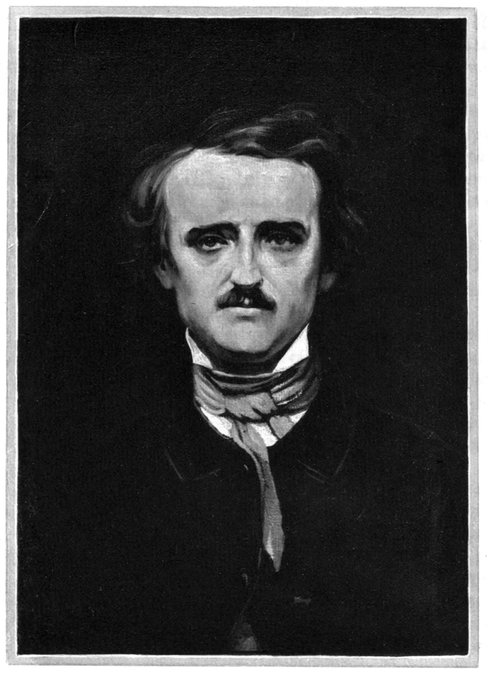
I had now gone so far as the conception of a Raven—the bird of ill omen—monotonously repeating the one word, “Nevermore,” at the conclusion of each stanza, in a poem of melancholy tone, and in length about one hundred lines. Now, never losing sight of the object supremeness, or perfection, at all points, I asked myself—“Of all melancholy topics, what, according to the universal understanding of mankind, is the most melancholy?” Death—was the obvious reply. “And when,” I said, “is this most melancholy of topics most poetical?” From what I have already explained at some length, the answer, here also, is obvious—“When it most closely allies itself to Beauty: the death, then, of a beautiful woman is, unquestionably, the most poetical topic in the world—and equally is it beyond doubt that the lips best suited for such topic are those of a bereaved lover.”
I had now to combine the two ideas, of a lover lamenting his deceased mistress and a Raven continuously repeating the word “Nevermore.” I had to combine these, bearing in mind my design of varying, at every turn, the application of the word repeated; but the only intelligible mode of such combination is that of imagining the Raven employing the word in answer to the queries of the lover. And here it was that I saw at once the opportunity afforded for the effect on which I had been depending—that is to say, the effect of the variation of application. I saw that I could make the first query propounded by the lover—the first query to which the Raven should reply “Nevermore”—that I could make this first query a commonplace one—the second less so—the third still less, and so on, until at length the lover—startled from his original nonchalance by the melancholy character of the word itself, by its frequent repetition, and by a consideration of the ominous reputation of the fowl that uttered it—is at length excited to superstition, and wildly propounds queries of a far different character—queries whose solution he has passionately at heart—propounds them half in superstition and half in that species of despair which delights in self-torture—propounds them not altogether because he believes in the prophetic or demoniac character of the bird (which, reason assures him, is merely repeating a lesson learned by rote) but because he experiences a phrenzied pleasure in so modeling his questions as to receive from the expected “Nevermore,” the most delicious because the most intolerable of sorrow. Perceiving the opportunity thus afforded me—or, more strictly, thus forced upon me in the progress of the construction—I first established in mind the climax, or concluding query—that query to which “Nevermore” should be in the last place an answer—that in reply to which this word “Nevermore” should involve the utmost conceivable amount of sorrow and despair.
Here, then, the poem may be said to have its beginning—at the end, where all works of art should begin—for it was here, at this point of my pre-considerations, that I first put pen to paper in the composition of the stanza:
I composed this stanza, at this point, first that, by establishing the climax, I might the better vary and graduate, as regards seriousness and importance, the preceding queries of the lover; and, secondly, that I might definitely settle the rhythm, the meter, and the length and general arrangement of the stanza, as well as graduate the stanzas which were to precede, so that none of them might surpass this in rhythmical effect. Had I been able, in the subsequent composition, to construct more vigorous stanzas, I should, without scruple, have purposely enfeebled them, so as not to interfere with the climacteric effect.
And here I may as well say a few words of the versification. My first object (as usual) was originality. The extent to which this has been neglected, in versification, is one of the most unaccountable things in the world. Admitting that there is little possibility of variety in mere rhythm, it is still clear that the possible varieties of meter and stanza are absolutely infinite—and yet, for centuries, no man, in verse, has ever done, or ever seemed to think of doing, an original thing. The fact is, that originality (unless in minds of very unusual force) is by no means a matter, as some suppose, of impulse or intuition. In general, to be found, it must be elaborately sought, and although a positive merit of the highest class, demands in its attainment less of invention than negation.
Of course, I pretend to no originality in either the rhythm or meter of “The Raven.” The former is trochaic—the latter is octameter acatalectic, alternating with heptameter catalectic repeated in the refrain of the fifth verse, and terminating with tetrameter catalectic. Less pedantically—the feet employed throughout (trochees) consist of a long syllable followed by a short: the first line of the stanza consists of eight of these feet—the second of seven and a half (in effect two-thirds)—the third of eight—the fourth of seven and a half—the fifth the same—the sixth, three and a half. Now, each of these lines, taken individually, has been employed before, and what originality “The Raven” has, is in their combination into stanza: nothing even remotely approaching this combination has ever been attempted. The effect of this originality of combination is aided by other unusual and some altogether novel effects, arising from an extension of the application of the principles of rhyme and alliteration.
The next point to be considered was the mode of bringing together the lover and the Raven—and the first branch of this consideration was the locale. For this the most natural suggestion might seem to be a forest, or the fields—but it has always appeared to me that a close circumscription of space is absolutely necessary to the effect of insulated incident: it has the force of a frame to a picture. It has an indisputable moral power in keeping concentrated the attention, and, of course, must not be confounded with mere unity of place.
I determined, then, to place the lover in his chamber—in a chamber rendered sacred to him by memories of her who had frequented it. The room is represented as richly furnished—this, in mere pursuance of the ideas I have already explained on the subject of beauty as the sole true poetical thesis.
The locale being thus determined, I had now to introduce the bird—and the thought of introducing him through the window was inevitable. The idea of making the lover suppose, in the first instance, that the flapping of the wings of the bird against the shutter is a “tapping” at the door, originated in a wish to increase, by prolonging, the reader’s curiosity, and in a desire to admit the incidental effect arising from the lover’s throwing open the door, finding all dark, and thence adopting the half-fancy that it was the spirit of his mistress that knocked.
I made the night tempestuous, first, to account for the Raven’s seeking admission, and, secondly, for the effect of contrast with the (physical) serenity within the chamber.
I made the bird alight on the bust of Pallas, also for the effect of contrast between the marble and the plumage—it being understood that the bust was absolutely suggested by the bird—the bust of Pallas being chosen, first, as most in keeping with the scholarship of the lover, and, secondly, for the sonorousness of the word, Pallas, itself.
About the middle of the poem, also, I have availed myself of the force of contrast, with a view of deepening the ultimate impression. For example, an air of the fantastic—approaching as nearly to the ludicrous as was admissible—is given to the Raven’s entrance. He comes in “with many a flirt and flutter.”
In the two stanzas which follow, the design is more obviously carried out:
The effect of the dénouement being thus provided for, I immediately drop the fantastic for a tone of the most profound seriousness—this tone commencing in the stanza directly following the one last quoted, with the line:
From this epoch the lover no longer jests—no longer sees anything even of the fantastic in the Raven’s demeanour. He speaks of him as a “grim, ungainly, ghastly, gaunt, and ominous bird of yore,” and feels the “fiery eyes” burning into his “bosom’s core.” This revolution of thought, or fancy, on the lover’s part, is intended to induce a similar one on the part of the reader—to bring the mind into a proper frame for the dénouement—which is now brought about as rapidly and as directly as possible.
With the dénouement proper—with the Raven’s reply, “Nevermore,” to the lover’s final demand if he shall meet his mistress in another world—the poem, in its obvious phase, that of a simple narrative, may be said to have its completion. So far, everything is within the limits of the accountable—of the real. A Raven, having learned by rote the single word, “Nevermore,” and having escaped from the custody of its owner, is driven at midnight, through the violence of a storm, to seek admission at a window from which a light still gleams,—the chamber-window of a student, occupied half in poring over a volume, half in dreaming of a beloved mistress deceased. The casement being thrown open at the fluttering of the bird’s wings, the bird itself perches on the most convenient seat out of the immediate reach of the student, who, amused by the incident and the oddity of the visitor’s demeanour, demands of it, in jest and without looking for a reply, its name. The Raven, addressed, answers with its customary word, “Nevermore,” a word which finds immediate echo in the melancholy heart of the student, who, giving utterance aloud to certain thoughts suggested by the occasion, is again startled by the fowl’s repetition of “Nevermore.” The student now guesses the state of the case, but is impelled, as I have before explained, by the human thirst for self-torture, and in part by superstition, to propound such queries to the bird as will bring him, the lover, the most of the luxury of sorrow, through the anticipated answer, “Nevermore.” With the indulgence, to the extreme, of this self-torture, the narration, in what I have termed its first or obvious phase, has a natural termination, and so far there has been no overstepping of the limits of the real.
But in subjects so handled, however skilfully, or with however vivid an array of incident, there is always a certain hardness or nakedness which repels the artistical eye. Two things are invariably required: first, some amount of complexity, or, more properly, adaptation; and, secondly, some amount of suggestiveness—some under-current, however indefinite, of meaning. It is this latter, in especial, which imparts to a work of art so much of that richness (to borrow from colloquy a forcible term) which we are too fond of confounding with the ideal. It is the excess of the suggested meaning—it is the rendering this the upper- instead of the under-current of the theme—which turns into prose (and that of the very flattest kind) the so-called poetry of the so-called transcendentalists.
Holding these opinions, I added the two concluding stanzas of the poem—their suggestiveness being thus made to pervade all the narrative which has preceded them. The under-current of meaning is rendered first apparent in the lines:
It will be observed that the words, “from out my heart,” involve the first metaphorical expression in the poem. They, with the answer, “Nevermore,” dispose the mind to seek a moral in all that has been previously narrated. The reader begins now to regard the Raven as emblematical—but it is not until the very last line of the very last stanza, that the intention of making him emblematical of Mournful and Never-ending Remembrance is permitted distinctly to be seen:
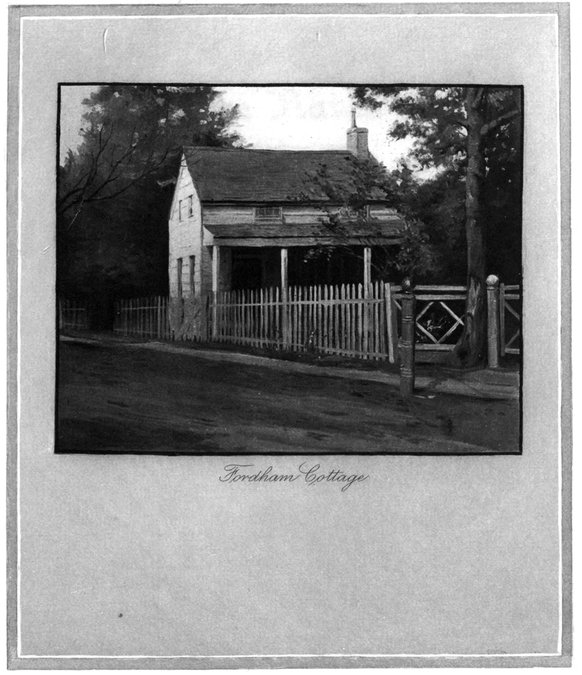
Fordham Cottage
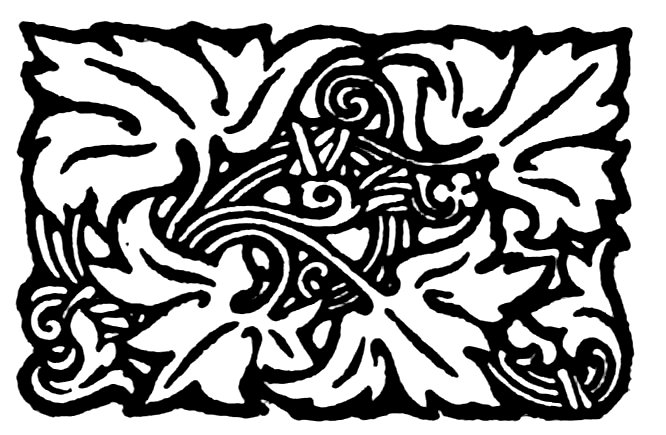
 Once upon a midnight dreary, while I pondered, weak and weary,
Once upon a midnight dreary, while I pondered, weak and weary, Ah, distinctly I remember it was in the bleak December,
Ah, distinctly I remember it was in the bleak December,
Copyright 1906 by The Harwell-Evans Co.
 And the silken, sad, uncertain rustling of each purple curtain
And the silken, sad, uncertain rustling of each purple curtain Presently my soul grew stronger; hesitating then no longer,
Presently my soul grew stronger; hesitating then no longer,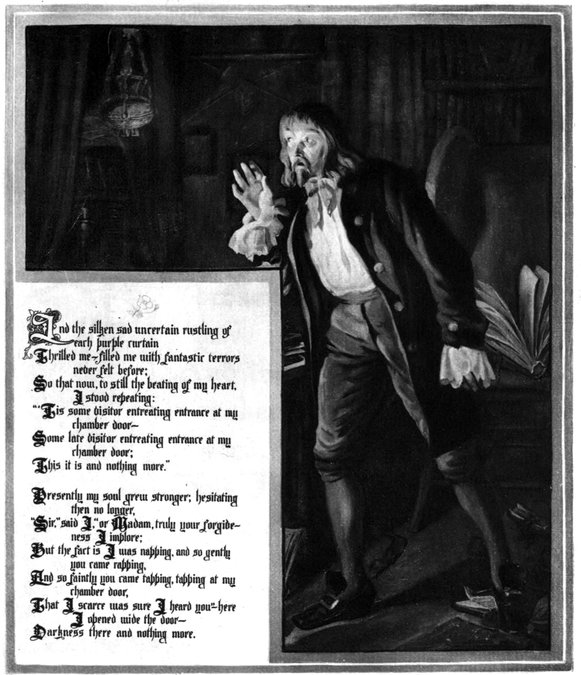
Copyright 1906 by The Harwell-Evans Co.
 Deep into that darkness peering, long I stood there wondering, fearing,
Deep into that darkness peering, long I stood there wondering, fearing, Back into the chamber turning, all my soul within me burning,
Back into the chamber turning, all my soul within me burning,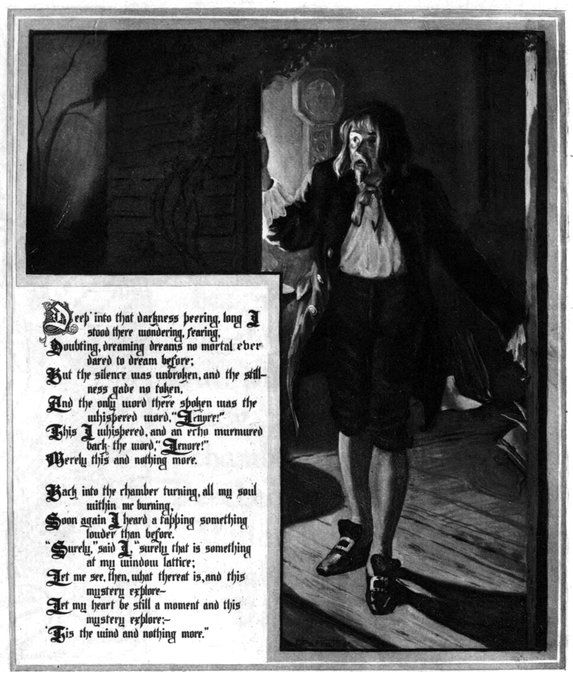
Copyright 1906 by The Harwell-Evans Co.
 Open here I flung the shutter, when, with many a flirt and flutter,
Open here I flung the shutter, when, with many a flirt and flutter, Then this ebony bird beguiling my sad fancy into smiling,
Then this ebony bird beguiling my sad fancy into smiling,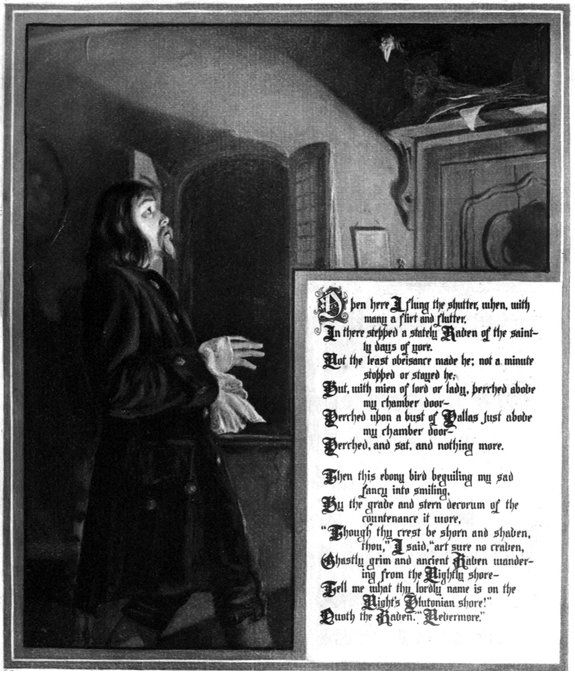
Copyright 1906 by The Harwell-Evans Co.
 Much I marvelled this ungainly fowl to hear discourse so plainly,
Much I marvelled this ungainly fowl to hear discourse so plainly, But the Raven, sitting lonely on the placid bust, spoke only
But the Raven, sitting lonely on the placid bust, spoke only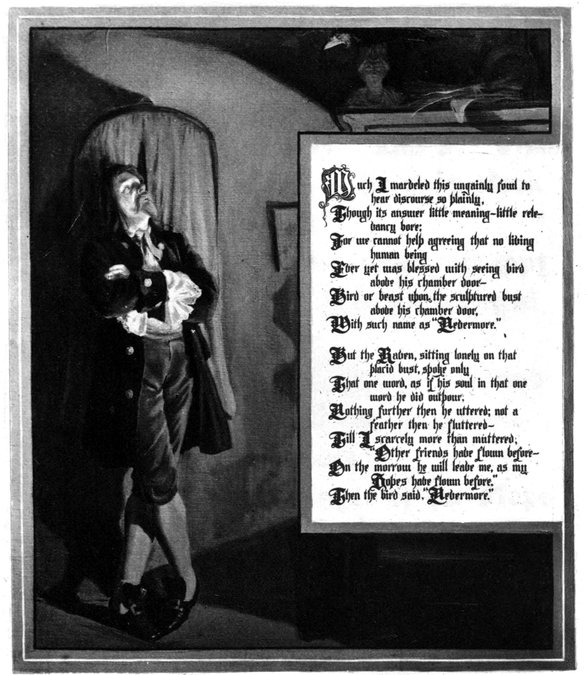
Copyright 1906 by The Harwell-Evans Co.
 Startled at the stillness broken by reply so aptly spoken,
Startled at the stillness broken by reply so aptly spoken, But the Raven still beguiling all my sad soul into smiling,
But the Raven still beguiling all my sad soul into smiling,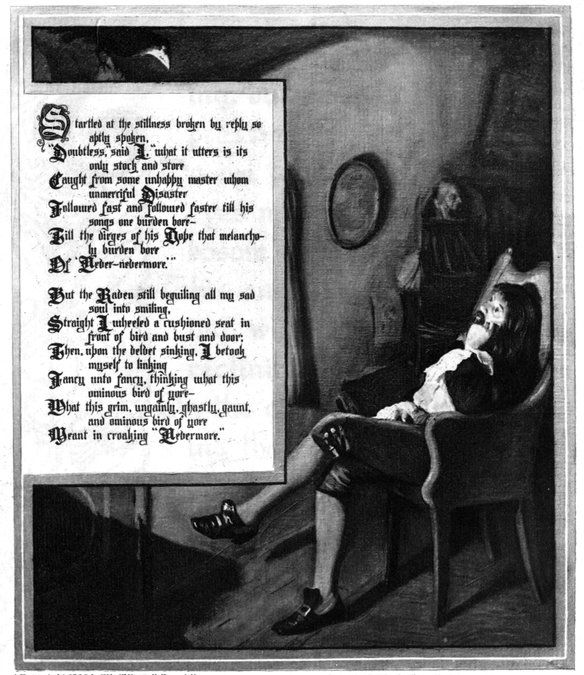
Copyright 1906 by The Harwell-Evans Co.
 This I sat engaged in guessing, but no syllable expressing
This I sat engaged in guessing, but no syllable expressing Then, methought, the air grew denser, perfumed from an unseen censer
Then, methought, the air grew denser, perfumed from an unseen censer
Copyright 1906 by The Harwell-Evans Co.
 “Prophet!” said I, “thing of evil!—prophet still, if bird or devil!—
“Prophet!” said I, “thing of evil!—prophet still, if bird or devil!— “Prophet!” said I, “thing of evil! prophet still, if bird or devil!—
“Prophet!” said I, “thing of evil! prophet still, if bird or devil!—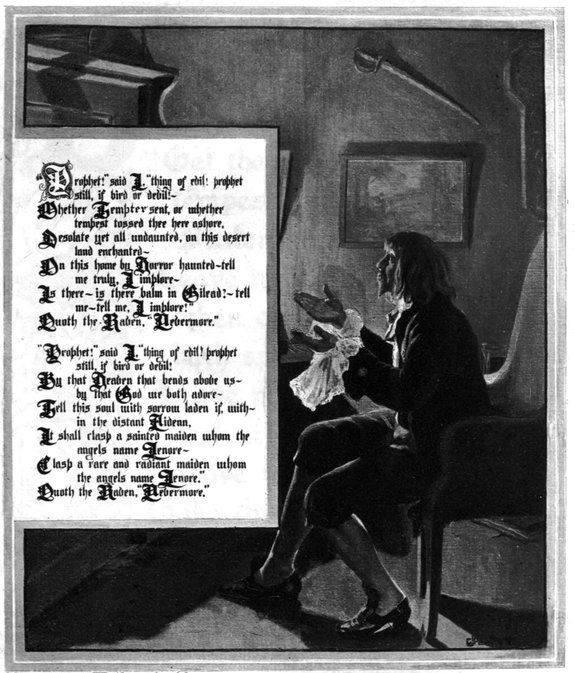
Copyright 1906 by The Harwell-Evans Co.
 “Be that word our sign of parting, bird or fiend!” I shrieked, upstarting—
“Be that word our sign of parting, bird or fiend!” I shrieked, upstarting— And the Raven, never flitting, still is sitting, still is sitting
And the Raven, never flitting, still is sitting, still is sitting
Copyright 1906 by The Harwell-Evans Co.
Here ends The Raven, a poem, and The Philosophy of Composition, a prose essay; the poem and the essay by Edgar Allan Poe, the photogravure illustrations from paintings by Galen J. Perrett, the initials and decorations by Will Jenkins, the typography designed by J. H. Nash. Of this first Quarto Photogravure Edition one thousand copies have been issued, printed on Arches handmade paper. Published by Paul Elder and Company and done into a book for them at the Tomoye Press, New York City. Finished this Tenth Day of July, in the year Nineteen Hundred and Seven.
End of the Project Gutenberg EBook of The Raven and The Philosophy of
Composition, by Edgar Allan Poe
*** END OF THIS PROJECT GUTENBERG EBOOK THE RAVEN, PHILOSOPHY OF COMPOSITION ***
***** This file should be named 55749-h.htm or 55749-h.zip *****
This and all associated files of various formats will be found in:
http://www.gutenberg.org/5/5/7/4/55749/
Produced by Richard Tonsing and the Online Distributed
Proofreading Team at http://www.pgdp.net (This file was
produced from images generously made available by The
Internet Archive)
Updated editions will replace the previous one--the old editions will
be renamed.
Creating the works from print editions not protected by U.S. copyright
law means that no one owns a United States copyright in these works,
so the Foundation (and you!) can copy and distribute it in the United
States without permission and without paying copyright
royalties. Special rules, set forth in the General Terms of Use part
of this license, apply to copying and distributing Project
Gutenberg-tm electronic works to protect the PROJECT GUTENBERG-tm
concept and trademark. Project Gutenberg is a registered trademark,
and may not be used if you charge for the eBooks, unless you receive
specific permission. If you do not charge anything for copies of this
eBook, complying with the rules is very easy. You may use this eBook
for nearly any purpose such as creation of derivative works, reports,
performances and research. They may be modified and printed and given
away--you may do practically ANYTHING in the United States with eBooks
not protected by U.S. copyright law. Redistribution is subject to the
trademark license, especially commercial redistribution.
START: FULL LICENSE
THE FULL PROJECT GUTENBERG LICENSE
PLEASE READ THIS BEFORE YOU DISTRIBUTE OR USE THIS WORK
To protect the Project Gutenberg-tm mission of promoting the free
distribution of electronic works, by using or distributing this work
(or any other work associated in any way with the phrase "Project
Gutenberg"), you agree to comply with all the terms of the Full
Project Gutenberg-tm License available with this file or online at
www.gutenberg.org/license.
Section 1. General Terms of Use and Redistributing Project
Gutenberg-tm electronic works
1.A. By reading or using any part of this Project Gutenberg-tm
electronic work, you indicate that you have read, understand, agree to
and accept all the terms of this license and intellectual property
(trademark/copyright) agreement. If you do not agree to abide by all
the terms of this agreement, you must cease using and return or
destroy all copies of Project Gutenberg-tm electronic works in your
possession. If you paid a fee for obtaining a copy of or access to a
Project Gutenberg-tm electronic work and you do not agree to be bound
by the terms of this agreement, you may obtain a refund from the
person or entity to whom you paid the fee as set forth in paragraph
1.E.8.
1.B. "Project Gutenberg" is a registered trademark. It may only be
used on or associated in any way with an electronic work by people who
agree to be bound by the terms of this agreement. There are a few
things that you can do with most Project Gutenberg-tm electronic works
even without complying with the full terms of this agreement. See
paragraph 1.C below. There are a lot of things you can do with Project
Gutenberg-tm electronic works if you follow the terms of this
agreement and help preserve free future access to Project Gutenberg-tm
electronic works. See paragraph 1.E below.
1.C. The Project Gutenberg Literary Archive Foundation ("the
Foundation" or PGLAF), owns a compilation copyright in the collection
of Project Gutenberg-tm electronic works. Nearly all the individual
works in the collection are in the public domain in the United
States. If an individual work is unprotected by copyright law in the
United States and you are located in the United States, we do not
claim a right to prevent you from copying, distributing, performing,
displaying or creating derivative works based on the work as long as
all references to Project Gutenberg are removed. Of course, we hope
that you will support the Project Gutenberg-tm mission of promoting
free access to electronic works by freely sharing Project Gutenberg-tm
works in compliance with the terms of this agreement for keeping the
Project Gutenberg-tm name associated with the work. You can easily
comply with the terms of this agreement by keeping this work in the
same format with its attached full Project Gutenberg-tm License when
you share it without charge with others.
1.D. The copyright laws of the place where you are located also govern
what you can do with this work. Copyright laws in most countries are
in a constant state of change. If you are outside the United States,
check the laws of your country in addition to the terms of this
agreement before downloading, copying, displaying, performing,
distributing or creating derivative works based on this work or any
other Project Gutenberg-tm work. The Foundation makes no
representations concerning the copyright status of any work in any
country outside the United States.
1.E. Unless you have removed all references to Project Gutenberg:
1.E.1. The following sentence, with active links to, or other
immediate access to, the full Project Gutenberg-tm License must appear
prominently whenever any copy of a Project Gutenberg-tm work (any work
on which the phrase "Project Gutenberg" appears, or with which the
phrase "Project Gutenberg" is associated) is accessed, displayed,
performed, viewed, copied or distributed:
This eBook is for the use of anyone anywhere in the United States and
most other parts of the world at no cost and with almost no
restrictions whatsoever. You may copy it, give it away or re-use it
under the terms of the Project Gutenberg License included with this
eBook or online at www.gutenberg.org. If you are not located in the
United States, you'll have to check the laws of the country where you
are located before using this ebook.
1.E.2. If an individual Project Gutenberg-tm electronic work is
derived from texts not protected by U.S. copyright law (does not
contain a notice indicating that it is posted with permission of the
copyright holder), the work can be copied and distributed to anyone in
the United States without paying any fees or charges. If you are
redistributing or providing access to a work with the phrase "Project
Gutenberg" associated with or appearing on the work, you must comply
either with the requirements of paragraphs 1.E.1 through 1.E.7 or
obtain permission for the use of the work and the Project Gutenberg-tm
trademark as set forth in paragraphs 1.E.8 or 1.E.9.
1.E.3. If an individual Project Gutenberg-tm electronic work is posted
with the permission of the copyright holder, your use and distribution
must comply with both paragraphs 1.E.1 through 1.E.7 and any
additional terms imposed by the copyright holder. Additional terms
will be linked to the Project Gutenberg-tm License for all works
posted with the permission of the copyright holder found at the
beginning of this work.
1.E.4. Do not unlink or detach or remove the full Project Gutenberg-tm
License terms from this work, or any files containing a part of this
work or any other work associated with Project Gutenberg-tm.
1.E.5. Do not copy, display, perform, distribute or redistribute this
electronic work, or any part of this electronic work, without
prominently displaying the sentence set forth in paragraph 1.E.1 with
active links or immediate access to the full terms of the Project
Gutenberg-tm License.
1.E.6. You may convert to and distribute this work in any binary,
compressed, marked up, nonproprietary or proprietary form, including
any word processing or hypertext form. However, if you provide access
to or distribute copies of a Project Gutenberg-tm work in a format
other than "Plain Vanilla ASCII" or other format used in the official
version posted on the official Project Gutenberg-tm web site
(www.gutenberg.org), you must, at no additional cost, fee or expense
to the user, provide a copy, a means of exporting a copy, or a means
of obtaining a copy upon request, of the work in its original "Plain
Vanilla ASCII" or other form. Any alternate format must include the
full Project Gutenberg-tm License as specified in paragraph 1.E.1.
1.E.7. Do not charge a fee for access to, viewing, displaying,
performing, copying or distributing any Project Gutenberg-tm works
unless you comply with paragraph 1.E.8 or 1.E.9.
1.E.8. You may charge a reasonable fee for copies of or providing
access to or distributing Project Gutenberg-tm electronic works
provided that
* You pay a royalty fee of 20% of the gross profits you derive from
the use of Project Gutenberg-tm works calculated using the method
you already use to calculate your applicable taxes. The fee is owed
to the owner of the Project Gutenberg-tm trademark, but he has
agreed to donate royalties under this paragraph to the Project
Gutenberg Literary Archive Foundation. Royalty payments must be paid
within 60 days following each date on which you prepare (or are
legally required to prepare) your periodic tax returns. Royalty
payments should be clearly marked as such and sent to the Project
Gutenberg Literary Archive Foundation at the address specified in
Section 4, "Information about donations to the Project Gutenberg
Literary Archive Foundation."
* You provide a full refund of any money paid by a user who notifies
you in writing (or by e-mail) within 30 days of receipt that s/he
does not agree to the terms of the full Project Gutenberg-tm
License. You must require such a user to return or destroy all
copies of the works possessed in a physical medium and discontinue
all use of and all access to other copies of Project Gutenberg-tm
works.
* You provide, in accordance with paragraph 1.F.3, a full refund of
any money paid for a work or a replacement copy, if a defect in the
electronic work is discovered and reported to you within 90 days of
receipt of the work.
* You comply with all other terms of this agreement for free
distribution of Project Gutenberg-tm works.
1.E.9. If you wish to charge a fee or distribute a Project
Gutenberg-tm electronic work or group of works on different terms than
are set forth in this agreement, you must obtain permission in writing
from both the Project Gutenberg Literary Archive Foundation and The
Project Gutenberg Trademark LLC, the owner of the Project Gutenberg-tm
trademark. Contact the Foundation as set forth in Section 3 below.
1.F.
1.F.1. Project Gutenberg volunteers and employees expend considerable
effort to identify, do copyright research on, transcribe and proofread
works not protected by U.S. copyright law in creating the Project
Gutenberg-tm collection. Despite these efforts, Project Gutenberg-tm
electronic works, and the medium on which they may be stored, may
contain "Defects," such as, but not limited to, incomplete, inaccurate
or corrupt data, transcription errors, a copyright or other
intellectual property infringement, a defective or damaged disk or
other medium, a computer virus, or computer codes that damage or
cannot be read by your equipment.
1.F.2. LIMITED WARRANTY, DISCLAIMER OF DAMAGES - Except for the "Right
of Replacement or Refund" described in paragraph 1.F.3, the Project
Gutenberg Literary Archive Foundation, the owner of the Project
Gutenberg-tm trademark, and any other party distributing a Project
Gutenberg-tm electronic work under this agreement, disclaim all
liability to you for damages, costs and expenses, including legal
fees. YOU AGREE THAT YOU HAVE NO REMEDIES FOR NEGLIGENCE, STRICT
LIABILITY, BREACH OF WARRANTY OR BREACH OF CONTRACT EXCEPT THOSE
PROVIDED IN PARAGRAPH 1.F.3. YOU AGREE THAT THE FOUNDATION, THE
TRADEMARK OWNER, AND ANY DISTRIBUTOR UNDER THIS AGREEMENT WILL NOT BE
LIABLE TO YOU FOR ACTUAL, DIRECT, INDIRECT, CONSEQUENTIAL, PUNITIVE OR
INCIDENTAL DAMAGES EVEN IF YOU GIVE NOTICE OF THE POSSIBILITY OF SUCH
DAMAGE.
1.F.3. LIMITED RIGHT OF REPLACEMENT OR REFUND - If you discover a
defect in this electronic work within 90 days of receiving it, you can
receive a refund of the money (if any) you paid for it by sending a
written explanation to the person you received the work from. If you
received the work on a physical medium, you must return the medium
with your written explanation. The person or entity that provided you
with the defective work may elect to provide a replacement copy in
lieu of a refund. If you received the work electronically, the person
or entity providing it to you may choose to give you a second
opportunity to receive the work electronically in lieu of a refund. If
the second copy is also defective, you may demand a refund in writing
without further opportunities to fix the problem.
1.F.4. Except for the limited right of replacement or refund set forth
in paragraph 1.F.3, this work is provided to you 'AS-IS', WITH NO
OTHER WARRANTIES OF ANY KIND, EXPRESS OR IMPLIED, INCLUDING BUT NOT
LIMITED TO WARRANTIES OF MERCHANTABILITY OR FITNESS FOR ANY PURPOSE.
1.F.5. Some states do not allow disclaimers of certain implied
warranties or the exclusion or limitation of certain types of
damages. If any disclaimer or limitation set forth in this agreement
violates the law of the state applicable to this agreement, the
agreement shall be interpreted to make the maximum disclaimer or
limitation permitted by the applicable state law. The invalidity or
unenforceability of any provision of this agreement shall not void the
remaining provisions.
1.F.6. INDEMNITY - You agree to indemnify and hold the Foundation, the
trademark owner, any agent or employee of the Foundation, anyone
providing copies of Project Gutenberg-tm electronic works in
accordance with this agreement, and any volunteers associated with the
production, promotion and distribution of Project Gutenberg-tm
electronic works, harmless from all liability, costs and expenses,
including legal fees, that arise directly or indirectly from any of
the following which you do or cause to occur: (a) distribution of this
or any Project Gutenberg-tm work, (b) alteration, modification, or
additions or deletions to any Project Gutenberg-tm work, and (c) any
Defect you cause.
Section 2. Information about the Mission of Project Gutenberg-tm
Project Gutenberg-tm is synonymous with the free distribution of
electronic works in formats readable by the widest variety of
computers including obsolete, old, middle-aged and new computers. It
exists because of the efforts of hundreds of volunteers and donations
from people in all walks of life.
Volunteers and financial support to provide volunteers with the
assistance they need are critical to reaching Project Gutenberg-tm's
goals and ensuring that the Project Gutenberg-tm collection will
remain freely available for generations to come. In 2001, the Project
Gutenberg Literary Archive Foundation was created to provide a secure
and permanent future for Project Gutenberg-tm and future
generations. To learn more about the Project Gutenberg Literary
Archive Foundation and how your efforts and donations can help, see
Sections 3 and 4 and the Foundation information page at
www.gutenberg.org
Section 3. Information about the Project Gutenberg Literary Archive Foundation
The Project Gutenberg Literary Archive Foundation is a non profit
501(c)(3) educational corporation organized under the laws of the
state of Mississippi and granted tax exempt status by the Internal
Revenue Service. The Foundation's EIN or federal tax identification
number is 64-6221541. Contributions to the Project Gutenberg Literary
Archive Foundation are tax deductible to the full extent permitted by
U.S. federal laws and your state's laws.
The Foundation's principal office is in Fairbanks, Alaska, with the
mailing address: PO Box 750175, Fairbanks, AK 99775, but its
volunteers and employees are scattered throughout numerous
locations. Its business office is located at 809 North 1500 West, Salt
Lake City, UT 84116, (801) 596-1887. Email contact links and up to
date contact information can be found at the Foundation's web site and
official page at www.gutenberg.org/contact
For additional contact information:
Dr. Gregory B. Newby
Chief Executive and Director
gbnewby@pglaf.org
Section 4. Information about Donations to the Project Gutenberg
Literary Archive Foundation
Project Gutenberg-tm depends upon and cannot survive without wide
spread public support and donations to carry out its mission of
increasing the number of public domain and licensed works that can be
freely distributed in machine readable form accessible by the widest
array of equipment including outdated equipment. Many small donations
($1 to $5,000) are particularly important to maintaining tax exempt
status with the IRS.
The Foundation is committed to complying with the laws regulating
charities and charitable donations in all 50 states of the United
States. Compliance requirements are not uniform and it takes a
considerable effort, much paperwork and many fees to meet and keep up
with these requirements. We do not solicit donations in locations
where we have not received written confirmation of compliance. To SEND
DONATIONS or determine the status of compliance for any particular
state visit www.gutenberg.org/donate
While we cannot and do not solicit contributions from states where we
have not met the solicitation requirements, we know of no prohibition
against accepting unsolicited donations from donors in such states who
approach us with offers to donate.
International donations are gratefully accepted, but we cannot make
any statements concerning tax treatment of donations received from
outside the United States. U.S. laws alone swamp our small staff.
Please check the Project Gutenberg Web pages for current donation
methods and addresses. Donations are accepted in a number of other
ways including checks, online payments and credit card donations. To
donate, please visit: www.gutenberg.org/donate
Section 5. General Information About Project Gutenberg-tm electronic works.
Professor Michael S. Hart was the originator of the Project
Gutenberg-tm concept of a library of electronic works that could be
freely shared with anyone. For forty years, he produced and
distributed Project Gutenberg-tm eBooks with only a loose network of
volunteer support.
Project Gutenberg-tm eBooks are often created from several printed
editions, all of which are confirmed as not protected by copyright in
the U.S. unless a copyright notice is included. Thus, we do not
necessarily keep eBooks in compliance with any particular paper
edition.
Most people start at our Web site which has the main PG search
facility: www.gutenberg.org
This Web site includes information about Project Gutenberg-tm,
including how to make donations to the Project Gutenberg Literary
Archive Foundation, how to help produce our new eBooks, and how to
subscribe to our email newsletter to hear about new eBooks.